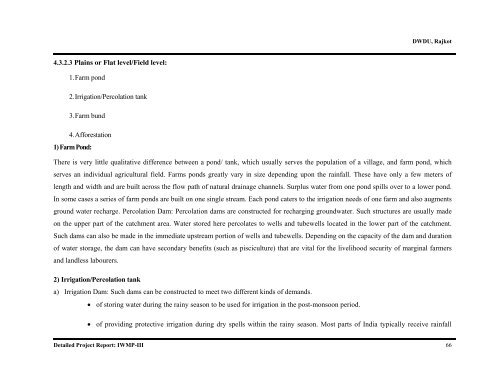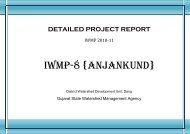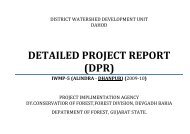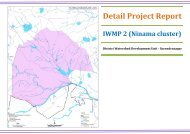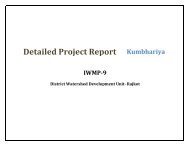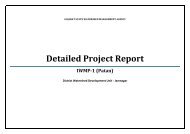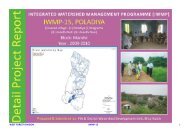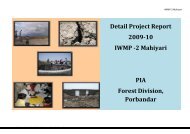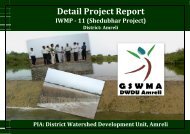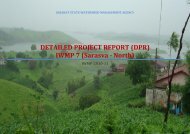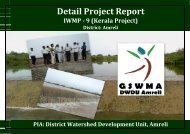IWMP-3 - Commissionerate of Rural Development Gujarat State ...
IWMP-3 - Commissionerate of Rural Development Gujarat State ...
IWMP-3 - Commissionerate of Rural Development Gujarat State ...
Create successful ePaper yourself
Turn your PDF publications into a flip-book with our unique Google optimized e-Paper software.
DWDU, Rajkot<br />
4.3.2.3 Plains or Flat level/Field level:<br />
1. Farm pond<br />
2. Irrigation/Percolation tank<br />
3. Farm bund<br />
4. Afforestation<br />
1) Farm Pond:<br />
There is very little qualitative difference between a pond/ tank, which usually serves the population <strong>of</strong> a village, and farm pond, which<br />
serves an individual agricultural field. Farms ponds greatly vary in size depending upon the rainfall. These have only a few meters <strong>of</strong><br />
length and width and are built across the flow path <strong>of</strong> natural drainage channels. Surplus water from one pond spills over to a lower pond.<br />
In some cases a series <strong>of</strong> farm ponds are built on one single stream. Each pond caters to the irrigation needs <strong>of</strong> one farm and also augments<br />
ground water recharge. Percolation Dam: Percolation dams are constructed for recharging groundwater. Such structures are usually made<br />
on the upper part <strong>of</strong> the catchment area. Water stored here percolates to wells and tubewells located in the lower part <strong>of</strong> the catchment.<br />
Such dams can also be made in the immediate upstream portion <strong>of</strong> wells and tubewells. Depending on the capacity <strong>of</strong> the dam and duration<br />
<strong>of</strong> water storage, the dam can have secondary benefits (such as pisciculture) that are vital for the livelihood security <strong>of</strong> marginal farmers<br />
and landless labourers.<br />
2) Irrigation/Percolation tank<br />
a) Irrigation Dam: Such dams can be constructed to meet two different kinds <strong>of</strong> demands.<br />
• <strong>of</strong> storing water during the rainy season to be used for irrigation in the post-monsoon period.<br />
• <strong>of</strong> providing protective irrigation during dry spells within the rainy season. Most parts <strong>of</strong> India typically receive rainfall<br />
Detailed Project Report: <strong>IWMP</strong>-III 66


